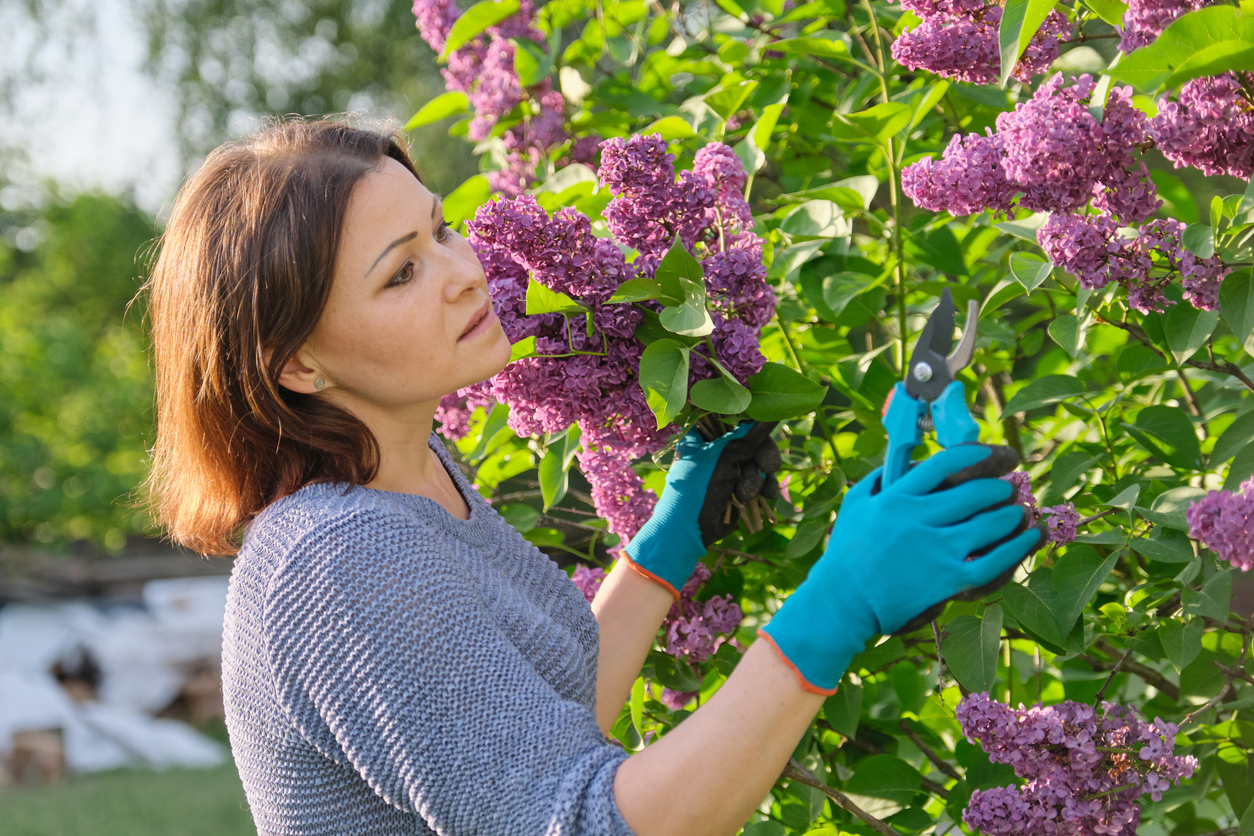

We may earn revenue from the products available on this page and participate in affiliate programs. Learn More ›
When considering how to prune lilacs, keep in mind that those shrubs reportedly flower better on newer wood, so you can do them a favor by removing some of the oldest canes. But “newer” is a relative term. Blooms usually don’t appear on wood younger than 3 years old, while 5- to 8-year-old canes generally produce the most flowers.
Therefore, your lilac bush care routine needn’t include pruning for a young shrub, except the deadheading of faded flowers and removal of dead or broken branches. However, once the lilac reaches 6 feet or so in height, it might appreciate rejuvenation pruning.
RELATED: How to Plant a Bush or Shrub
When to Prune Lilac Bushes for Regular Maintenance
If you are debating on when to prune lilacs, the simple answer is that they should be pruned within 2 weeks after they finish blooming in spring. Cutting at any other time of year would be a mistake, since it’s during summer that lilac bushes begin making buds, which persist over winter for the next spring’s bloom.
However, should you prefer to prune when the plant is free of foliage, you can do so in late winter, even though you’ll be removing potential flowers that way. No matter which trimming option you choose, follow the steps below to learn how to prune a lilac bush.
Tools & Materials
Bobvila.com may earn a commission from purchases made through these links.
BEFORE YOU BEGIN

It helps to know that these steps include routine maintenance pruning (which is minimal for lilacs) and rejuvenation pruning. When applied to pruning lilac bushes, rejuvenation pruning can suggest a drastic cutting back of those shrubs in late winter—to within about 6 inches from the ground—to promote all new growth. However, such extreme measures will eliminate all blooms for at least 1 or 2 years, since lilac buds begin forming soon after they completed their last spring’s bloom.
When trimming lilac bushes for rejuvenation, therefore, most gardeners prefer to remove a third of the oldest canes annually for 3 years. That way, youthful vigor can be restored gradually without eliminating blooms.
Before pruning lilacs, soak the blades of your tools in a sterilizing solution—such as 70 percent rubbing alcohol or Lysol disinfectant—for 5 minutes to prevent the spread of disease. Then, rinse the blades in water and allow them to dry before use.
STEP 1: Deadhead your lilac bushes by removing faded flowers.

Begin pruning lilac bushes by removing all of the shriveled blooms as they fade. To do so, find the first pair of leaves beneath a faded flower cluster and snip just above those leaves. You should be able to use bypass pruning shears for this, unless the stems are larger than ¼ inch in diameter. In that case, try bypass loppers instead.
STEP 2: Remove dead, broken, larvae-infested, or rubbing canes at the base.
For the next phase of your lilac care routine, remove any canes that appear damaged or infested with pests such as the lilac borer. (Small holes at the bases of shoots, accompanied by sawdust, often indicate borers.) Where two canes are rubbing together, remove the weakest one to prevent it from damaging the stronger one.
STEP 3: To rejuvenate the bush, prune 1/3 of its old canes.

If your bush has aged enough to require rejuvenation pruning, cut out a third of the oldest (largest in diameter) canes, snipping them off at the base. You probably will need bypass loppers instead of bypass pruning shears for this. For canes larger than an inch in diameter, use a pruning saw instead.
STEP 4: Remove all suckers on grafted bushes and most suckers on others.
If your lilac is a grafted shrub, your lilac bush trimming procedure should include removing all of the suckers (new shoots that spring up at the base of the plant). Unless you’re growing a living fence, remove most of the suckers for a bush growing on its own roots, leaving only enough suckers to replace the older canes that you pruned.
RELATED: The Best Things You Can Do for Your Yard This Fall
STEP 5: Remove another 1/3 of the oldest canes annually for 3 years.

After your lilac is a few years old or about 6 feet tall, remove another third of the old canes during the next spring, and repeat the process once more the following spring. Once all of the oldest growth has been cut out, you can allow the shrub to grow unchecked for about 3 years, after which point you should repeat the rejuvenation process.
STEP 6: Propagate new bushes with your lilac cuttings (optional).
If you are looking for information on how to propagate lilacs, keep in mind that the cuttings should be at just the right stage to root properly. Those that snap promptly when you bend them are the best fit for propagation. If the cuttings are too young and tender or too old and tough to snap, they probably won’t work. Snip 3- to 5-inch cuttings with at least two leaf nodes each and follow these directions for rooting softwood cuttings.
